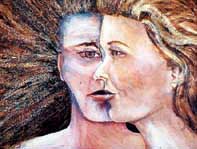types of depression
 These
are terms that are mainly used by psychologists to plan treatment--the exact
diagnosis is unlikely to seem all that relevant to the average person. One thing
to notice, though, is that not all of the symptoms of depression are necessary
to make a diagnosis of some type of depression. If depression is significantly
interfering with your life, you should see a psychologist even if you don't
have all of the symptoms of a major depression.
These
are terms that are mainly used by psychologists to plan treatment--the exact
diagnosis is unlikely to seem all that relevant to the average person. One thing
to notice, though, is that not all of the symptoms of depression are necessary
to make a diagnosis of some type of depression. If depression is significantly
interfering with your life, you should see a psychologist even if you don't
have all of the symptoms of a major depression.
In major depression, most of
the symptoms of depression are present. This is the most severe category of
depression. Single episode depression occurs when an individual has an episode
of major depression that responds to treatment and does not recur. Recurrent
depression occurs when an individual has periods of depression. In between these
periods of depression, the person may go years before being depressed again.
Reactive depression (also called
adjustment disorder with depressed mood) is mild or moderate depression in response
to a trauma (for example, breaking up a relationship). In general, the symptoms
can be treated within six months.
Dysthymic disorder is mild depression
that persists for at least two years. People with dysthymic disorder often develop
major depression in response to a traumatic event.
Depression, not otherwise specified,
is a catch-all term used by psychologists when a set of symptoms don't fit into
one of the other diagnoses.
Bipolar disorder, or manic depression,
is characterized by the presence of at least one manic episode. Many people
with bipolar disorder have alternating periods of mania and depression. However,
some are repeatedly depressed and only occasionally experience mania, while
others have more of a problem with mania. The symptoms of mania and depression
may also occur together.
Sources
Psychology Information
Online
 These
are terms that are mainly used by psychologists to plan treatment--the exact
diagnosis is unlikely to seem all that relevant to the average person. One thing
to notice, though, is that not all of the symptoms of depression are necessary
to make a diagnosis of some type of depression. If depression is significantly
interfering with your life, you should see a psychologist even if you don't
have all of the symptoms of a major depression.
These
are terms that are mainly used by psychologists to plan treatment--the exact
diagnosis is unlikely to seem all that relevant to the average person. One thing
to notice, though, is that not all of the symptoms of depression are necessary
to make a diagnosis of some type of depression. If depression is significantly
interfering with your life, you should see a psychologist even if you don't
have all of the symptoms of a major depression.